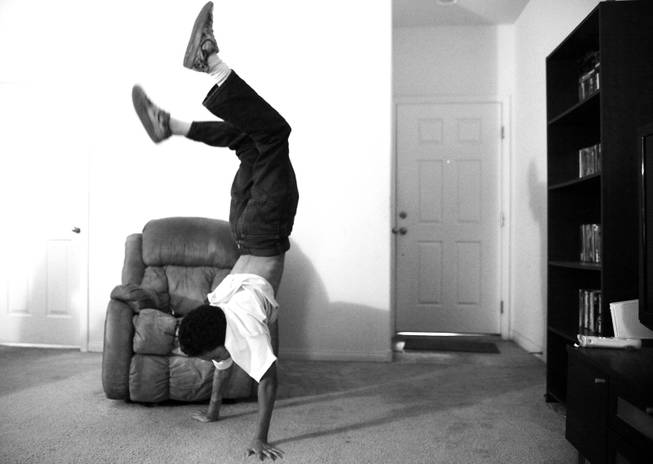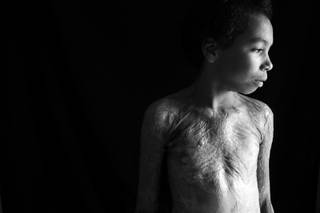
Bishop Smith, 11, of North Las Vegas, who was badly burned in an accident in 2008, is still recovering from his injuries but can now walk on his hands again.
Thursday, Feb. 9, 2012 | 2 a.m.
As 11-year-old Bishop Smith stands on his hands, his impressive balancing act draws more stares than the scars revealed by his gravity-pulled T-shirt.
Nearly 10 seconds later, Bishop brings his feet back to earth, smiling sheepishly at what he just accomplished. Three years ago, the odds were stacked against Bishop to live a normal life, much less perform lengthy handstands.
He was in
University Medical Center’s burn unit, his body 25 percent covered with third-degree burns on his arms and chest. The pain was intense, almost indescribable.
“It kind of hurt a lot,” Bishop said, understating the healing process for wounds he said resembled raw meat.
At night, two people held his arms in a stainless steel shower room as other nurses scraped off dead tissue and slough, exposing open nerve cells.
“He’s been a soldier,” said his father, Jason Smith.
It’s stories like Bishop’s that make fire officials preach the importance of fire safety: Keep matches and lighters away from children. Store flammable liquids outside. Stop careless smoking. And if a fire does start, evacuate first and then call 9-1-1.
About 45,000 people nationwide were hospitalized for burn injuries in 2011, according to the
American Burn Association. An estimated 3,500 people died from smoke inhalation or burn wounds last year, with 75 percent of those deaths occurring on scene or during medical transport, the organization reported.
“The bottom line is you never, ever want to get burned,” said Tim Szymanski,
Las Vegas Fire and Rescue’spublic education and information officer. “It is the worst possible thing that could ever happen to you. I’d rather be hit by a truck than have to suffer burns because they stay with you the rest of your life.”
That’s why Szymanski treats each day as if it were part of
Burn Awareness Week, which runs through Saturday. He regularly meets with community members, fields calls from concerned parents and sees burn victims at fire scenes.
Cooking fires are the most common in Las Vegas and the nation, but Szymanski said the department responds each year to roughly 25 fires started by children and another dozen started by medical oxygen users who decide to smoke — a decision with potentially deadly results because oxygen acts as a fire accelerant.
“If you have medical oxygen, the rule should be no smoking, period,” he said.
A similar principle should be applied to fire and children, Szymanski said.
“You wouldn’t believe how many requests we get from people who say, ‘Come and yell at my kids and scare them,’” he said.
As with that case, Szymanski said most children play with fire out of curiosity, which is why telling children not to touch matches or lighters fails.
“A match or a lighter is as deadly as a gun in the hands of a child,” he said. “They should be treated exactly the same.”
It was a lighter that changed Bishop’s life on a windy morning, Dec. 2, 2008.
Then 8 years old, he was walking to
D.L. Dickens Elementary School in North Las Vegas with a friend who lived a few blocks away. It was a morning ritual for the two boys.
That day, however, his friend had swiped his mother’s lighter before they left the house, and Bishop proceeded to flick it on and off. The wind swept the flame onto his shirt, immediately igniting it from the bottom up.
A neighbor heard Bishop’s screams and helped hose him down with water. He remembers paramedics sticking him with needles — morphine to dull the pain — and then waking up in a hospital.
He spent two months at UMC, followed by three months of physical therapy and then six weeks as a sponsored patient at a
Shriners Hospital for Children in Sacramento, Calif., which paid for his medical expenses. He’s one of more than 400 local patients treated at Shriners Hospitals in neighboring states.
The Shriners Hospital for Children assisted Bishop Smith on the road to recovery.
The Justin Timberlake Shriners Hospitals for Children Open at TPC Summerlin, Oct. 1-7 this year, is an annual fundraiser for the charity.
“It was basically the difference,” his father said of Shriners, where Bishop enjoyed the company of other injured children. “It pretty much gave him a second chance.”
In all, Bishop endured nearly a dozen surgeries by spring 2009, and he had another surgery in August 2011 to improve mobility in skin graft locations affected by growth.
A single father to Bishop and a 15-year-old son, Smith said the first year after the accident was “the biggest test” of his life.
“I couldn’t give him a hug for a long time,” Smith said. “Everything hurt.”
For Bishop, that also meant not bending his arms for long periods of time and, as a result, not being able to pet his dog, Scrappy.
Bishop faces occasional surgeries as he continues growing, but he’s back to his old pursuits: playing basketball, walking Scrappy, doing handstands and chasing lizards.
“He’s like a pistol,” Smith said. “Even before he got hurt, he was always in the middle of stuff and cracking jokes.”
Even so, Smith said his son’s experience should serve as a reminder to other parents about how quickly fire-related accidents can happen.
“Let (children) know the things that could happen,” he said. “I guess I got lucky because I did some pretty dangerous, stupid stuff when I was a kid.”
His son’s advice is even simpler: “If you do play with fire, don’t do it.”
If Bishop’s dream to become a professional basketball player doesn’t work out, he said he has another career path in mind — firefighter.


![[Print]](http://djcoregon.com/wp-content/plugins/dmc_sociable_toolbar/print.png)
![[Email]](http://djcoregon.com/wp-content/plugins/dmc_sociable_toolbar/email_2.png)
![[RSS Feed]](http://djcoregon.com/wp-content/plugins/dmc_sociable_toolbar/rssfeed.png)
![[del.icio.us]](http://djcoregon.com/wp-content/plugins/dmc_sociable_toolbar/delicious.png)
![[Facebook]](http://djcoregon.com/wp-content/plugins/dmc_sociable_toolbar/facebook.png)



